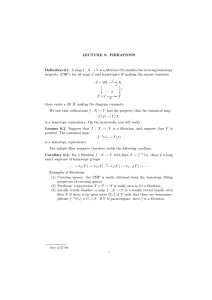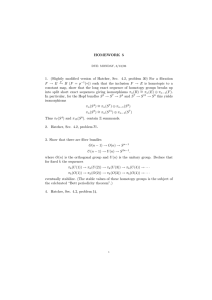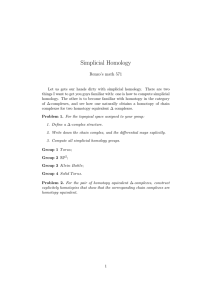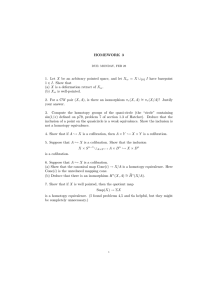LECTURE 6: PUSHOUTS AND PULLBACKS, THE ... FIBER 1. Pushouts and pullbacks →
advertisement
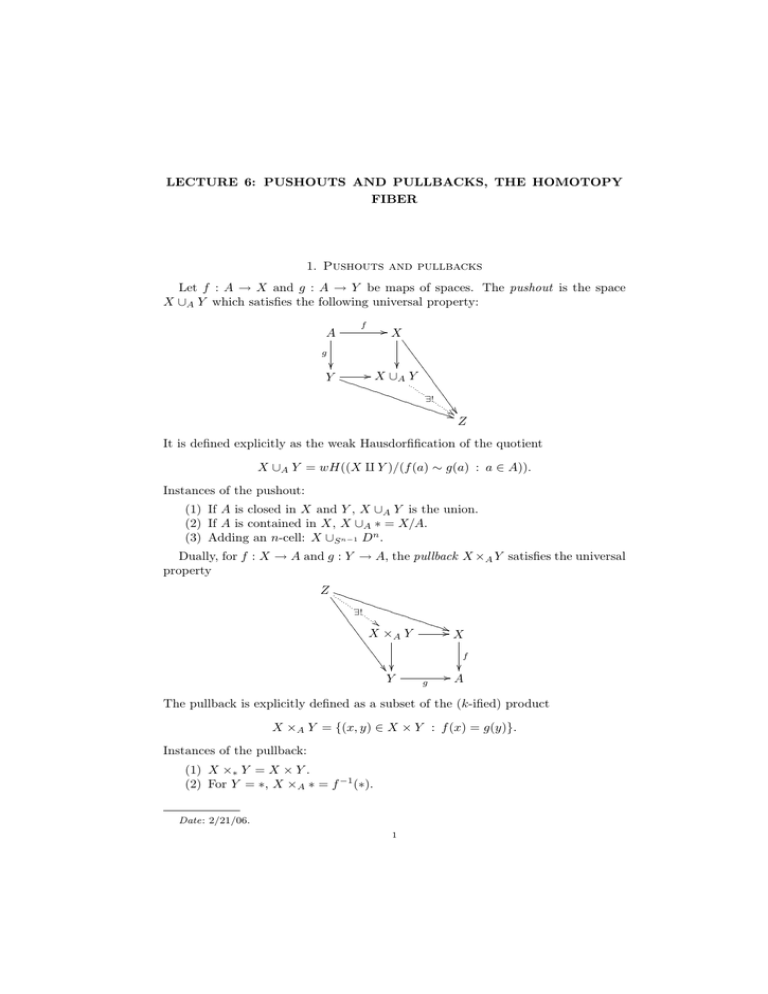
LECTURE 6: PUSHOUTS AND PULLBACKS, THE HOMOTOPY
FIBER
1. Pushouts and pullbacks
Let f : A → X and g : A → Y be maps of spaces. The pushout is the space
X ∪A Y which satisfies the following universal property:
A
f
/
X
55
5
5
5
5
55
Y SSSS / X ∪A Y 5
5
5
SSS
5
SSS
SSS ∃!
5
55
SSS 5
SSS# )
Z
g
It is defined explicitly as the weak Hausdorfification of the quotient
X ∪A Y = wH((X � Y )/(f (a) ∼ g(a) : a ∈ A)).
Instances of the pushout:
(1) If A is closed in X and Y , X ∪A Y is the union.
(2) If A is contained in X, X ∪A ∗ = X/A.
(3) Adding an n­cell: X ∪S n−1 Dn .
Dually, for f : X → A and g : Y → A, the pullback X ×A Y satisfies the universal
property
Z 5
SSSS
5
5
SSSS
55 ∃! SSSSS
SSSS
55
SSS
)
55 #
/ X
55X ×A Y
55
55
f
5
/A
Y
g
The pullback is explicitly defined as a subset of the (k­ified) product
X ×A Y = {(x, y) ∈ X × Y : f (x) = g(y)}.
Instances of the pullback:
(1) X ×∗ Y = X × Y .
(2) For Y = ∗, X ×A ∗ = f −1 (∗).
Date: 2/21/06.
1
2. The homotopy fiber
Let f : X → Y be a map of pointed spaces. The homotopy fiber F (f ) is defined
to be the pullback
/X
F (f )
f
Map∗ (I, Y )
ev1
/Y
where ev1 is the evaluation at 1 map. Thus F (f ) is the space of pairs (x, γ) where
x ∈ X and γ : ∗ → f (x) is a path in Y . The fiber of f is the inverse image f −1 (∗).
The homotopy fiber is an up to homotopy version: it consists of x ∈ X together
with homotopies of f (x) to ∗.
One of the uses of the homotopy fiber is that it completes a long exact sequence
of homotopy groups:
f∗
· · · → πn (F (f )) → πn (X) −→ πn (Y )
∂
−
→ πn−1 (F (f )) → · · ·
···
f∗
· · · → π0 (F (f )) → π0 (X) −→ π0 (Y ).
In light of the following lemma, this is a generalization of the LES of a pair.
Lemma 2.1. Let i : A �→ X be an inclusion. There is an isomorphism πk (X, A) ∼
=
πk−1 (F (i)).
Lemma 2.2. Consider the lifting problem (in Top∗ ):
Z
g
�
}
F (f )
g
j
/X
f
/Y
There is a bijective correspondence:
{lifts g�}
�
{pointed null homotopies gf � ∗}
Corollary 2.3. Let Z be a pointed space. The sequence
f
F (f ) → X −
→Y
induces an exact sequence of sets
f∗
[Z, F (f )]∗ → [Z, X]∗ −→ [Z, Y ]∗ .
Letting Z = S n recovers the exact sequence of homotopy groups at one stage.
2
